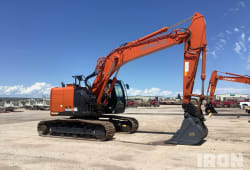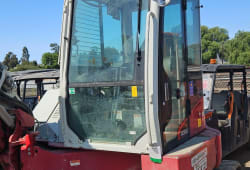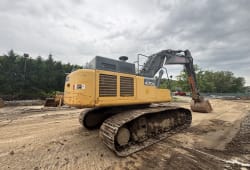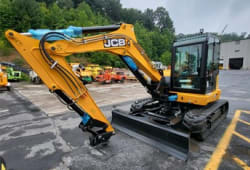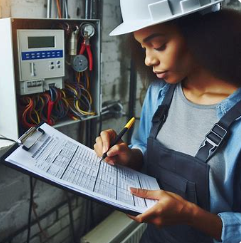Strategies to Identify Good Used Construction Equipment
4 Min read
)
March 6, 2024
When it comes to purchasing used construction equipment, ensuring that you're investing in quality machinery is paramount for the success of your projects. In this guide, we'll explore effective strategies for identifying good used construction equipment to help you make informed purchasing decisions and avoid costly mistakes.
Introduction to Identifying Good Used Construction Equipment
Importance of Proper Identification
Properly identifying good used construction equipment is crucial for ensuring reliability, efficiency, and safety on job sites. Investing in high-quality machinery can significantly impact project outcomes, productivity, and overall profitability.
Benefits of Investing in Quality Equipment
Quality equipment offers numerous benefits, including enhanced performance, reduced downtime, lower maintenance costs, and improved resale value. By prioritizing the identification of good-used construction equipment, businesses can maximize their return on investment and achieve long-term success.
Visual Inspection of Used Construction Equipment
:format(webp))
Exterior Condition
Begin by visually inspecting the exterior of the equipment for any visible signs of damage, rust, corrosion, or structural issues. Pay close attention to the overall appearance, paint condition, and presence of dents or scratches, which may indicate poor maintenance or previous accidents.
Signs of Wear and Tear
Check for common wear and tear indicators such as worn-out tires, tracks, buckets, and hydraulic hoses. Assess the condition of critical components, including undercarriages, booms, arms, and attachments, to gauge the overall integrity and lifespan of the equipment.
Mechanical Assessment of Used Construction Equipment
Engine Performance
Evaluate the engine performance by starting the equipment and listening for any unusual noises, vibrations, or smoke emissions. Monitor engine temperature, oil pressure, and fluid levels to ensure optimal operation and identify potential mechanical issues or malfunctions.
Hydraulic System Integrity
Inspect the hydraulic system for leaks, cracks, or hydraulic fluid contamination, which can indicate hydraulic cylinder or seal failures. Test the responsiveness and functionality of hydraulic controls, cylinders, and hoses to verify proper operation and performance.
Testing Functionality of Used Construction Equipment
Operational Tests
Operate the equipment and perform various tasks relevant to its intended use, such as lifting, digging, loading, and maneuvering. Assess the equipment's responsiveness, power, and precision to determine its overall functionality and suitability for your specific needs.
Functional Checks
Test specific features and functions of the equipment, including lights, gauges, brakes, steering, and safety systems, to ensure that they are in proper working order. Address any identified issues or deficiencies promptly to prevent potential safety hazards or operational disruptions.
Documentation and Maintenance History
Importance of Maintenance Records
Request comprehensive maintenance records and service history documentation from the seller to verify the equipment's maintenance and repair activities. Review maintenance logs, inspection reports, and warranty information to assess the equipment's care and condition over time.
Verifying Service History
Verify the authenticity and accuracy of the provided maintenance records by cross-referencing them with reputable service providers or authorized dealerships. Look for consistent maintenance intervals, documented repairs, and adherence to manufacturer guidelines and recommendations.
Professional Inspection Services for Used Construction Equipment
Hiring Certified Inspectors
Consider hiring certified inspectors or qualified technicians to conduct thorough inspections and evaluations of the equipment. Professional inspectors have the expertise, tools, and experience to identify hidden issues, assess overall conditions, and provide unbiased recommendations based on industry standards.
Evaluating Inspection Reports
Carefully review and analyze inspection reports and findings to gain valuable insights into the equipment's condition, performance, and potential risks. Use the information provided by professional inspectors to make informed decisions and negotiate effectively with the seller.
Negotiation and Pricing Strategies for Used Construction Equipment
Understanding Market Value
Research the market value of similar used construction equipment models and configurations to establish a fair and competitive price range. Consider factors such as age, usage, condition, features, and market demand when negotiating pricing with the seller.
Factors Affecting Pricing
Take into account various factors that may affect the pricing of used construction equipment, including market trends, economic conditions, supply and demand dynamics, and seller motivations. Be prepared to negotiate terms, warranties, and financing options to achieve a mutually beneficial agreement.
Conclusion
Identifying good used construction equipment requires careful inspection, evaluation, and consideration of various factors to ensure quality, reliability, and value for your investment. By following the strategies outlined in this guide and prioritizing thorough due diligence, businesses can confidently purchase used construction equipment that meets their needs and exceeds their expectations.
Visit Boom & Bucket to buy and sell your machinery.

Mike Kennedy is Boom & Bucket's Marketplace Operations Manager, where he leads shipping, warranties, and post-sale operations to create a seamless buyer experience. As one of the company's earliest team members, Mike helped build the foundation of Boom & Bucket's operations and guided its growth through acquisition by RB Global. He is passionate about scaling marketplaces, solving operational challenges, and improving efficiency to deliver industry-leading results.
